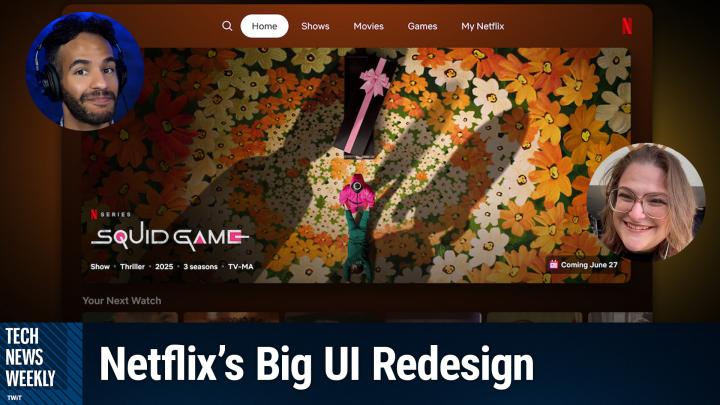Netflix's Major UI Overhaul
AI-created, human-reviewed.
Netflix's Major UI Overhaul: How Algorithms Will Keep You Watching Longer
Netflix is rolling out its most significant redesign in years, and the goal is clear: keep subscribers watching—and subscribing—longer than ever before. As discussed by Mikah Sargent on a recent episode of Tech News Weekly, this update represents a fundamental shift in how the streaming giant approaches user retention and engagement.
New Navigation and Personalized Home Experience
One of the most visible changes is the navigation, which will move to a horizontal bar at the top of the screen. The interface will split into two primary sections: a "Home" tab focused on algorithm-driven discovery and a "My Netflix" tab for user-curated content.
This separation marks a strategic shift. The Home tab will become Netflix's algorithmic playground—a place where the platform can surface what it thinks you want to watch based on increasingly sophisticated data analysis. Meanwhile, the My Netflix tab gives users a sense of control over their viewing experience through personally selected content.
Real-Time Recommendation Engine
Perhaps the most significant change is how recommendations will now work. According to Netflix CTO Elizabeth Stone, the platform's new algorithm will update suggestions in real-time as you browse, not just based on your viewing history.
"Before, Netflix would process what you've watched in the background and update recommendations the next time you launched the app," Sargent explained. "Now, it's constantly watching you. If you finish a show and immediately search for more serial killer content, new titles will start surfacing under relevant categories right away."
This real-time responsiveness aims to reduce the moments when viewers might become bored and consider logging off. The algorithm will even factor in contextual elements like time of day, potentially showing different content options during late-night viewing sessions versus Sunday afternoons.
A Vertical Video Feed for Mobile
Taking cues from social media platforms like TikTok and Instagram, Netflix is testing a vertically scrolling feed of short video clips on mobile devices. These clips aren't random—they're specifically chosen to entice viewers to start watching shows or to share content with friends.
"I think this is one of the aspects that I find most compelling," Sargent noted on the podcast. "Sharing clips and scenes is a huge part of what makes shows take off these days." The integration of shareable short-form content represents Netflix's acknowledgment of how social media drives viewing decisions.
AI-Powered Natural Language Search
Netflix is also experimenting with an AI-driven search feature powered by OpenAI. This opt-in feature will allow iPhone users to search using natural language queries like "something dark and funny, but not too funny," with the system interpreting these subjective requests.
The feature will initially roll out to iPhones before potentially expanding to other platforms. This limitation highlights another challenge for Netflix—the varying timelines for implementing updates across different devices and smart TV platforms.
The Business Behind the Redesign
While these changes may improve user experience, they serve a clear business purpose. Despite having lower churn rates than most competitors, Netflix remains focused on keeping subscribers engaged—and paying.
The redesign also has implications for Netflix's advertising strategy. As Sargent pointed out, "Netflix's chief product officer, Eunice Kim, teased that the redesign offers 'flexibility to evolve the homepage' and could 'drive outcomes for advertisers.'" This suggests the new interface may eventually feature more personalized ad experiences for subscribers on the ad-supported tier.
What This Means for Viewers
This comprehensive update represents what some are calling the "TikTokification" of Netflix—an embrace of algorithmic content delivery designed to maximize engagement through personalization and real-time adaptation.
For viewers, the changes might make discovering new content easier and more intuitive. However, as Sargent wondered during the podcast, these changes also raise questions: "Will you be able to reset the algorithm if you feel it doesn't understand your preferences? Will you be able to change it if you feel it knows you too well?"
The redesign ultimately reflects a broader trend in streaming services—the growing dominance of algorithms in determining not just what we watch, but how we watch it. As Netflix continues to evolve, one thing is certain: the days of asking "Are you still watching?" are being replaced by a system designed to ensure the answer is always "yes."
